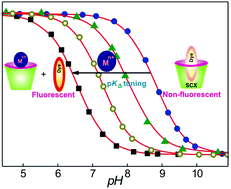Metal ion-induced supramolecular pKa tuning and fluorescence regeneration of a p-sulfonatocalixarene encapsulated neutral red dye†
Abstract
The host–guest interactions and the consequent modulation in the prototropic equilibrium of a phenazine dye, neutral red, with p-sulfonatocalix[4]arene (SCX4) and p-sulfonatocalix[6]arene (SCX6) macrocyclic hosts have been investigated. Both the neutral (NR) and cationic (NRH+) forms of dyes formed inclusion complexes with SCX6, with a larger binding constant for the latter (K = 8.6 × 105 M−1versus 4.8 × 103 M−1) due to the cation receptor behavior of the calixarenes. The distinct differences in the binding constant of NR and NRH+ provided a finite tuning of pKa between 6.5 and 8.8, through a competitive binding with metal ions. Importantly, the fluorescence quenching observed in the SCX–neutral red interactions stands in contrast to the fluorescence enhancement observed with other macrocyclic hosts, such as β-cyclodextrin and cucurbit[7]uril. This is due to the unique portal stacking interaction of NRH+ with the SCXs, compared to the axial inclusion geometry documented for the other macrocycles. The electron transfer from the SCX to the neutral red dye is adjudged to be the effective excited-state relaxation pathway leading to fluorescence quenching. In combination with the metal-ion induced fluorescence regeneration and tuning the pKa value, the SCX–neutral red system finds potential applications in drug delivery, photodynamic therapy, catalysis, and sensor applications.



 Please wait while we load your content...
Please wait while we load your content...